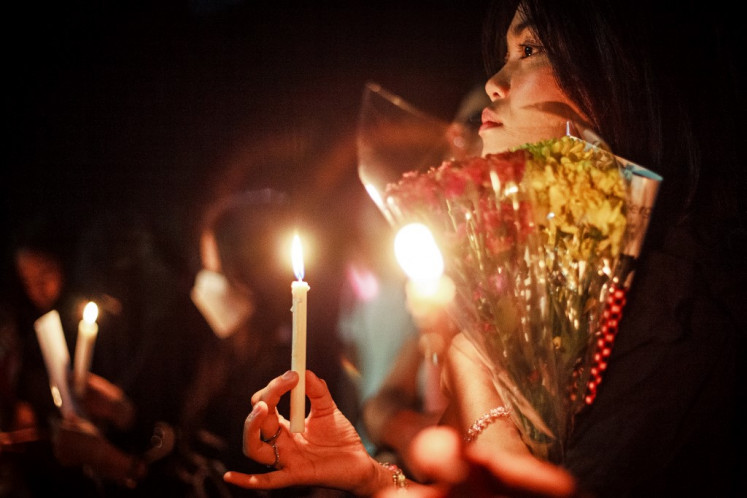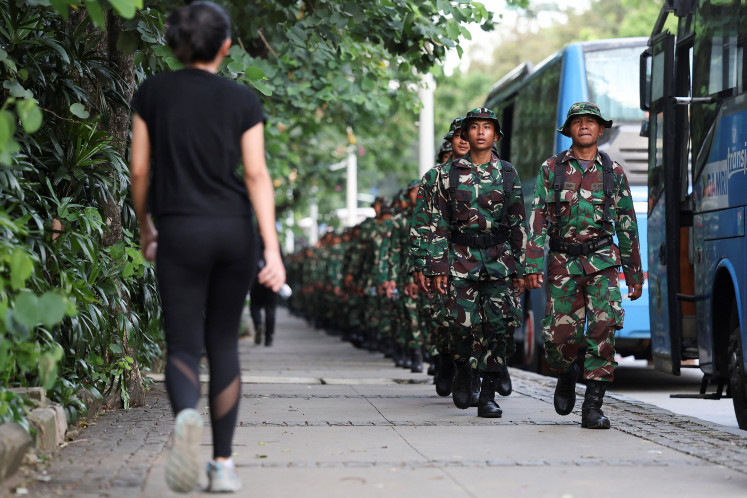Popular Reads
Top Results
Can't find what you're looking for?
View all search resultsPopular Reads
Top Results
Can't find what you're looking for?
View all search resultsAchieving happiness through a cup of tea
Tea makers: Tea utensils â matcha container, tea spoon, bamboo whisk, bowl and folded napkin to wipe the bowl â are prepared for the chanoyu tea ceremony
Change text size
Gift Premium Articles
to Anyone
![Tea makers: Tea utensils â matcha container, tea spoon, bamboo whisk, bowl and folded napkin to wipe the bowl â are prepared for the chanoyu tea ceremony.(Courtesy of Vikhtoria of Urasenke Takokai Indone)" border="0" height="385" width="510"><span class="caption"><strong>Tea makers: </strong>Tea utensils â matcha container, tea spoon, bamboo whisk, bowl and folded napkin to wipe the bowl â are prepared for the chanoyu tea ceremony.(Courtesy of Vikhtoria of Urasenke Takokai Indone)</span></span></span></span></p><p>As a ceremony, a <em>chanoyu</em> (Japanese tea ritual) feels like theater, where participants have to perform their roles precisely as prescribed.</p><p><em>Chanoyu</em> (Japanese tea ceremony) demonstrations are mostly silent events involving a kimono-clad female host sitting on a chair on a<em> tatami</em> mat floor, religiously preparing a bowl of powdered green tea called <em>matcha. </em><br><br>The frothy whipped tea is served to the guest of honor by the hostâs assistant followed by other ladies with tea already prepared serving the rest. After all the guests have drunk the tea, the ceremony is over but might be repeated for one or two more rounds. <br><br>The publicly showcased act of painstaking, ritualized hospitality, imported to Indonesia as part of Japanâs soft power, invokes tranquility, predefined orderliness and courtesy that make the audience feel honored. It brings out the best in both the host and the guests through the exercise of aesthetics and etiquette.<br><br>Indonesian Suwarni Widjaja, the first <em>chanoyu</em> instructor of non-Japanese descent ever bestowed with a Japanese Ambassador Commendation, said that a private tea ceremony was usually attended by four or five guests.<br><br>It usually consists of four parts: a<em> kaiseki</em> (traditional multicourse Japanese dining) session; a <em>chanoyu </em>session where a bowl of thick tea is shared among the guests; a snack session; and a <em>chanoyu</em> session where thin tea is served in a separate bowl to each guest.<br><br><em>âChanoyu,</em> (philosophically) also referred to as chado or the way of tea, is held as [part of] a celebration of an important event in a personâs life,â Suwarni said. <br><br>She was speaking on the sidelines of a recent <em>chanoyu</em> event she held in Jakarta to celebrate the commendation conferred to her by Japanese Ambassador Yasuaki Tanizaki in November last year.<br><br>While four of Suwarniâs fellow instructors were also recipients, two receiving the same commendation as her and two earning Japanese Foreign Minister Commendations, they were Japanese who have become Indonesian citizens. <br><br>Suwarni, who has been studying<em> chanoyu</em> for 28 years, is currently the only Indonesian deemed worthy by Japan of such a commendation.<br><br>A short course tutored by Suwarni at her Bungur Tea House, focusing on the ceremonyâs <em>tatami</em>-seated version instead of the chair-seated ceremony intended for mostly non-Japanese guests, teaches participants in detail all the ritualistic acts and movements they are to correctly, exactly and elegantly follow in silence. So, <em>chanoyu </em>feels like a pantomime theater where participants have prescribed roles to play. There is no room for improvisation nor impromptu acts. <br><br>Playing the role of a host or a guest, one has to remember and observe all the ceremonyâs rules, like wearing white socks (which signify purity) before entering the<em> tatami</em> room, which Suwarni calls âthe room of peace and equalityâ. </p><p><span class="inline inline-center"><img class="image image-_original " src="http://202.158.21.182/files/images2/21Ritualized.jpg" alt="Ritualized hospitality: Suwarni Widjaja, the first Indonesian chanoyu instructor of non-Japanese descent ever bestowed with a Japanese Ambassador Commendation, performs the chanoyu tea ceremony in Jakarta.(Courtesy of Vikthtoria/Urasenke Takokai Indonesia)" title="Ritualized hospitality: Suwarni Widjaja, the first Indonesian chanoyu instructor of non-Japanese descent ever bestowed with a Japanese Ambassador Commendation, performs the chanoyu tea ceremony in Jakarta.(Courtesy of Vikthtoria/Urasenke Takokai Indonesia)" border="0" height="491" width="341"><span class="caption"><strong>Ritualized hospitality: </strong>Suwarni Widjaja, the first Indonesian <em>chanoyu </em>instructor of non-Japanese descent ever bestowed with a Japanese Ambassador Commendation, performs the<em> chanoyu</em> tea ceremony in Jakarta.(Courtesy of Vikthtoria/Urasenke Takokai Indonesia)</span></span><br><br>All jewelry, wristwatches and hierarchical or social status attributes have to be taken off as everyone in the <em>tatami</em> room is equal. In the past, even samurai warriors and other combatants have to leave their swords and other weapons outside upon entering the <em>tatami </em>room. Women are not permitted to wear perfume or trousers in the room, which has to be entered with the right foot first and exited with the left foot first. <br><br>Upon entry, one has to bow down as a sign of respect â to the room, to the unassuming <em>chabana</em> (flowers-of-the field arrangement) and to the hanging scroll whose âharmonyâ, ârespectâ, âpurityâ and âtranquilityâ calligraphy echoes the principles established by one of the founding fathers of <em>chanoyu</em>, Sen no Rikyu (1522-1591). <br><br>It was Rikyuâs philosophical ideals including simplicity and austerity which, Suwarni said, drew her to<em> chanoyu</em> in the first instance. <br><br>Then one has to sit <em>seiza</em>-style â kneeling on the floor, folding oneâs legs underneath oneâs thighs, while resting the buttocks on the heels, slightly separating the knees with the back kept straight â on the <em>tatami </em>floor, which is uncomfortable. <br><br>The tea was ceremonial-grade <em>matcha</em>. It is typically bitter although it can also be savory with some sweetness like its culinary-grade counterpart. <br><br>The bitterness is balanced by mochi, beautifully crafted bite-sized sweet cakes which, Suwarni said, could be âmore delicious than the teaâ, and are intended to prevent stomach upsets as drinking <em>matcha</em> means ingesting the whole leaf, not just the brewed water; its caffeine content is thus much higher than a cup of steeped tea, which is not good on an empty stomach. <br><br>When returning the bowl, one has to turn to face the host by making two quarter turns counterclockwise. If the bowl is a<em> karamono</em> (priceless porcelain tea bowl from Song or Tang Dynasty China), an extra handling ritual has to be observed to prevent it from breaking.<br><br>Throughout the ceremony, the host drinks and eats nothing. Communication has to be non-verbal, with the guest telling the host how good the tea was by making a soft, audible sucking noise upon drinking the last drop. </p><p><span class="inline inline-center"><img class="image image-img_assist_custom-511x288 " src="http://202.158.21.182/files/images2/toattea.img_assist_custom-511x288.jpg" alt="To at tea: A bowl of frothy whipped matcha and the bamboo whisk used to create the froth covered with a layer of foam.(Arif Suryobuwono)" title="To at tea: A bowl of frothy whipped matcha and the bamboo whisk used to create the froth covered with a layer of foam.(Arif Suryobuwono)](https://www.thejakartapost.com/files/images2/21Teamakers_0.img_assist_custom-510x387.jpg) Tea makers: Tea utensils â matcha container, tea spoon, bamboo whisk, bowl and folded napkin to wipe the bowl â are prepared for the chanoyu tea ceremony.(Courtesy of Vikhtoria of Urasenke Takokai Indone)" border="0" height="385" width="510">Tea makers: Tea utensils â matcha container, tea spoon, bamboo whisk, bowl and folded napkin to wipe the bowl â are prepared for the chanoyu tea ceremony.(Courtesy of Vikhtoria of Urasenke Takokai Indone)
Tea makers: Tea utensils â matcha container, tea spoon, bamboo whisk, bowl and folded napkin to wipe the bowl â are prepared for the chanoyu tea ceremony.(Courtesy of Vikhtoria of Urasenke Takokai Indone)" border="0" height="385" width="510">Tea makers: Tea utensils â matcha container, tea spoon, bamboo whisk, bowl and folded napkin to wipe the bowl â are prepared for the chanoyu tea ceremony.(Courtesy of Vikhtoria of Urasenke Takokai Indone)As a ceremony, a chanoyu (Japanese tea ritual) feels like theater, where participants have to perform their roles precisely as prescribed.
Chanoyu (Japanese tea ceremony) demonstrations are mostly silent events involving a kimono-clad female host sitting on a chair on a tatami mat floor, religiously preparing a bowl of powdered green tea called matcha.
The frothy whipped tea is served to the guest of honor by the hostâs assistant followed by other ladies with tea already prepared serving the rest. After all the guests have drunk the tea, the ceremony is over but might be repeated for one or two more rounds.
The publicly showcased act of painstaking, ritualized hospitality, imported to Indonesia as part of Japanâs soft power, invokes tranquility, predefined orderliness and courtesy that make the audience feel honored. It brings out the best in both the host and the guests through the exercise of aesthetics and etiquette.
Indonesian Suwarni Widjaja, the first chanoyu instructor of non-Japanese descent ever bestowed with a Japanese Ambassador Commendation, said that a private tea ceremony was usually attended by four or five guests.
It usually consists of four parts: a kaiseki (traditional multicourse Japanese dining) session; a chanoyu session where a bowl of thick tea is shared among the guests; a snack session; and a chanoyu session where thin tea is served in a separate bowl to each guest.
âChanoyu, (philosophically) also referred to as chado or the way of tea, is held as [part of] a celebration of an important event in a personâs life,â Suwarni said.
She was speaking on the sidelines of a recent chanoyu event she held in Jakarta to celebrate the commendation conferred to her by Japanese Ambassador Yasuaki Tanizaki in November last year.
While four of Suwarniâs fellow instructors were also recipients, two receiving the same commendation as her and two earning Japanese Foreign Minister Commendations, they were Japanese who have become Indonesian citizens.
Suwarni, who has been studying chanoyu for 28 years, is currently the only Indonesian deemed worthy by Japan of such a commendation.
A short course tutored by Suwarni at her Bungur Tea House, focusing on the ceremonyâs tatami-seated version instead of the chair-seated ceremony intended for mostly non-Japanese guests, teaches participants in detail all the ritualistic acts and movements they are to correctly, exactly and elegantly follow in silence. So, chanoyu feels like a pantomime theater where participants have prescribed roles to play. There is no room for improvisation nor impromptu acts.
Playing the role of a host or a guest, one has to remember and observe all the ceremonyâs rules, like wearing white socks (which signify purity) before entering the tatami room, which Suwarni calls âthe room of peace and equalityâ.
 Ritualized hospitality: Suwarni Widjaja, the first Indonesian chanoyu instructor of non-Japanese descent ever bestowed with a Japanese Ambassador Commendation, performs the chanoyu tea ceremony in Jakarta.(Courtesy of Vikthtoria/Urasenke Takokai Indonesia)
Ritualized hospitality: Suwarni Widjaja, the first Indonesian chanoyu instructor of non-Japanese descent ever bestowed with a Japanese Ambassador Commendation, performs the chanoyu tea ceremony in Jakarta.(Courtesy of Vikthtoria/Urasenke Takokai Indonesia)
All jewelry, wristwatches and hierarchical or social status attributes have to be taken off as everyone in the tatami room is equal. In the past, even samurai warriors and other combatants have to leave their swords and other weapons outside upon entering the tatami room. Women are not permitted to wear perfume or trousers in the room, which has to be entered with the right foot first and exited with the left foot first.
Upon entry, one has to bow down as a sign of respect â to the room, to the unassuming chabana (flowers-of-the field arrangement) and to the hanging scroll whose âharmonyâ, ârespectâ, âpurityâ and âtranquilityâ calligraphy echoes the principles established by one of the founding fathers of chanoyu, Sen no Rikyu (1522-1591).
It was Rikyuâs philosophical ideals including simplicity and austerity which, Suwarni said, drew her to chanoyu in the first instance.
Then one has to sit seiza-style â kneeling on the floor, folding oneâs legs underneath oneâs thighs, while resting the buttocks on the heels, slightly separating the knees with the back kept straight â on the tatami floor, which is uncomfortable.
The tea was ceremonial-grade matcha. It is typically bitter although it can also be savory with some sweetness like its culinary-grade counterpart.
The bitterness is balanced by mochi, beautifully crafted bite-sized sweet cakes which, Suwarni said, could be âmore delicious than the teaâ, and are intended to prevent stomach upsets as drinking matcha means ingesting the whole leaf, not just the brewed water; its caffeine content is thus much higher than a cup of steeped tea, which is not good on an empty stomach.
When returning the bowl, one has to turn to face the host by making two quarter turns counterclockwise. If the bowl is a karamono (priceless porcelain tea bowl from Song or Tang Dynasty China), an extra handling ritual has to be observed to prevent it from breaking.
Throughout the ceremony, the host drinks and eats nothing. Communication has to be non-verbal, with the guest telling the host how good the tea was by making a soft, audible sucking noise upon drinking the last drop.
 Tea makers: <)
Tea makers: <)
T
span class="caption">Tea makers: Tea utensils ' matcha container, tea spoon, bamboo whisk, bowl and folded napkin to wipe the bowl ' are prepared for the chanoyu tea ceremony.(Courtesy of Vikhtoria of Urasenke Takokai Indone)
As a ceremony, a chanoyu (Japanese tea ritual) feels like theater, where participants have to perform their roles precisely as prescribed.
Chanoyu (Japanese tea ceremony) demonstrations are mostly silent events involving a kimono-clad female host sitting on a chair on a tatami mat floor, religiously preparing a bowl of powdered green tea called matcha.
The frothy whipped tea is served to the guest of honor by the host's assistant followed by other ladies with tea already prepared serving the rest. After all the guests have drunk the tea, the ceremony is over but might be repeated for one or two more rounds.
The publicly showcased act of painstaking, ritualized hospitality, imported to Indonesia as part of Japan's soft power, invokes tranquility, predefined orderliness and courtesy that make the audience feel honored. It brings out the best in both the host and the guests through the exercise of aesthetics and etiquette.
Indonesian Suwarni Widjaja, the first chanoyu instructor of non-Japanese descent ever bestowed with a Japanese Ambassador Commendation, said that a private tea ceremony was usually attended by four or five guests.
It usually consists of four parts: a kaiseki (traditional multicourse Japanese dining) session; a chanoyu session where a bowl of thick tea is shared among the guests; a snack session; and a chanoyu session where thin tea is served in a separate bowl to each guest.
'Chanoyu, (philosophically) also referred to as chado or the way of tea, is held as [part of] a celebration of an important event in a person's life,' Suwarni said.
She was speaking on the sidelines of a recent chanoyu event she held in Jakarta to celebrate the commendation conferred to her by Japanese Ambassador Yasuaki Tanizaki in November last year.
While four of Suwarni's fellow instructors were also recipients, two receiving the same commendation as her and two earning Japanese Foreign Minister Commendations, they were Japanese who have become Indonesian citizens.
Suwarni, who has been studying chanoyu for 28 years, is currently the only Indonesian deemed worthy by Japan of such a commendation.
A short course tutored by Suwarni at her Bungur Tea House, focusing on the ceremony's tatami-seated version instead of the chair-seated ceremony intended for mostly non-Japanese guests, teaches participants in detail all the ritualistic acts and movements they are to correctly, exactly and elegantly follow in silence. So, chanoyu feels like a pantomime theater where participants have prescribed roles to play. There is no room for improvisation nor impromptu acts.
Playing the role of a host or a guest, one has to remember and observe all the ceremony's rules, like wearing white socks (which signify purity) before entering the tatami room, which Suwarni calls 'the room of peace and equality'.
Ritualized hospitality: Suwarni Widjaja, the first Indonesian chanoyu instructor of non-Japanese descent ever bestowed with a Japanese Ambassador Commendation, performs the chanoyu tea ceremony in Jakarta.(Courtesy of Vikthtoria/Urasenke Takokai Indonesia)
All jewelry, wristwatches and hierarchical or social status attributes have to be taken off as everyone in the tatami room is equal. In the past, even samurai warriors and other combatants have to leave their swords and other weapons outside upon entering the tatami room. Women are not permitted to wear perfume or trousers in the room, which has to be entered with the right foot first and exited with the left foot first.
Upon entry, one has to bow down as a sign of respect ' to the room, to the unassuming chabana (flowers-of-the field arrangement) and to the hanging scroll whose 'harmony', 'respect', 'purity' and 'tranquility' calligraphy echoes the principles established by one of the founding fathers of chanoyu, Sen no Rikyu (1522-1591).
It was Rikyu's philosophical ideals including simplicity and austerity which, Suwarni said, drew her to chanoyu in the first instance.
Then one has to sit seiza-style ' kneeling on the floor, folding one's legs underneath one's thighs, while resting the buttocks on the heels, slightly separating the knees with the back kept straight ' on the tatami floor, which is uncomfortable.
The tea was ceremonial-grade matcha. It is typically bitter although it can also be savory with some sweetness like its culinary-grade counterpart.
The bitterness is balanced by mochi, beautifully crafted bite-sized sweet cakes which, Suwarni said, could be 'more delicious than the tea', and are intended to prevent stomach upsets as drinking matcha means ingesting the whole leaf, not just the brewed water; its caffeine content is thus much higher than a cup of steeped tea, which is not good on an empty stomach.
When returning the bowl, one has to turn to face the host by making two quarter turns counterclockwise. If the bowl is a karamono (priceless porcelain tea bowl from Song or Tang Dynasty China), an extra handling ritual has to be observed to prevent it from breaking.
Throughout the ceremony, the host drinks and eats nothing. Communication has to be non-verbal, with the guest telling the host how good the tea was by making a soft, audible sucking noise upon drinking the last drop.
To at tea: A bowl of frothy whipped matcha and the bamboo whisk used to create the froth covered with a layer of foam.(Arif Suryobuwono)
As the ceremony ends, conversation with the host starts. Guests are to admire the beauty of the bowl and other tea utensils and make enquiries thereof.
'Chanoyu is not only about tea. It encompasses all connected aspects including how to make the perfect charcoal fire [to heat the water kettle], how to look after the utensils and prepare the powdered tea, how to appreciate art [including calligraphy], poetry, pottery, pick wild flowers in the right season for chabana, etc [...] there is so much to learn in a lifetime,' said Suwarni, who periodically goes to Japan to learn more skills.
That is the way of tea, crosscutting and holistic, where the end is not visible as things keep on changing. That is the path traversed by Suwarni and other followers of Urasenke, one of Japan's main chanoyu schools. 'There is innermost pleasure in my heart [whenever] I am in the way of tea,' she said.
' For details on chanoyu workshops, email workshopchado@gmail.com.










